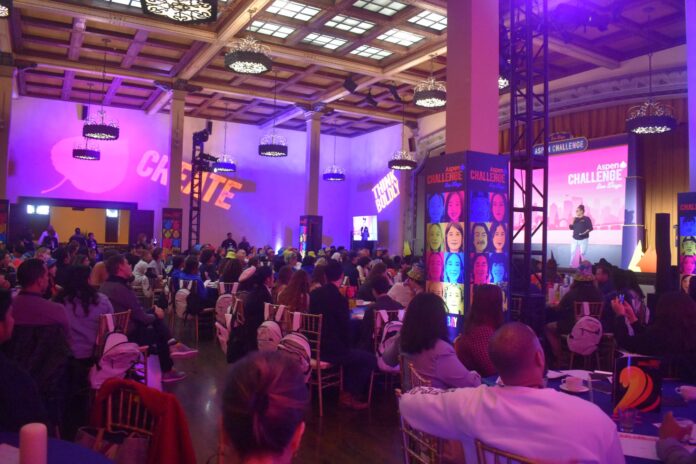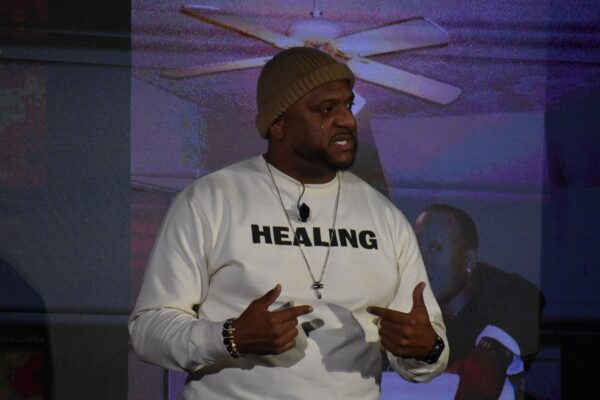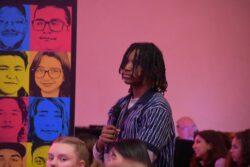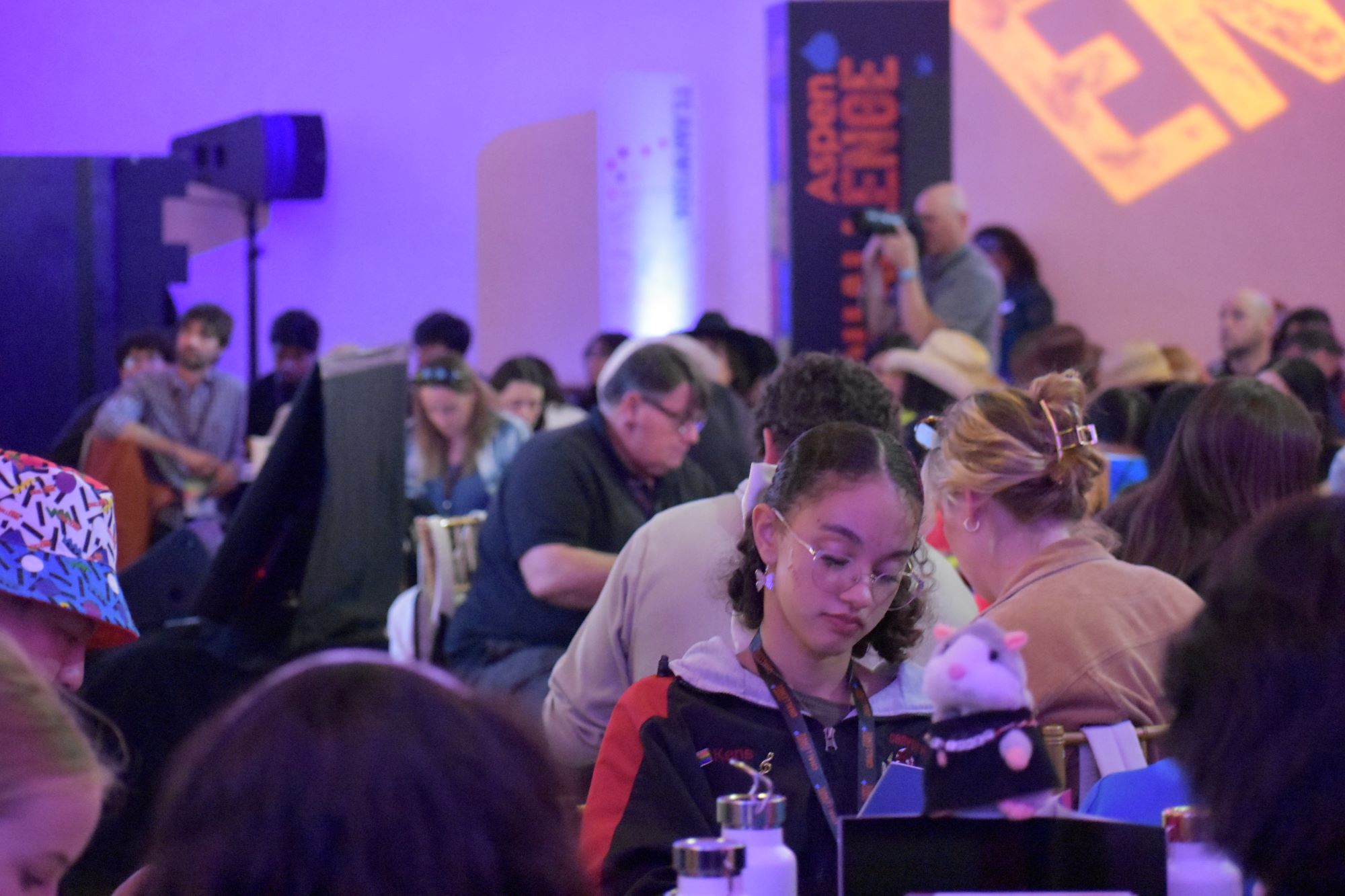
By Macy Meinhardt, Voice & Viewpoint Staff Writer
Hundreds of high school students across San Diego Unified District convened last Wednesday for the Aspen Challenge; a youth-led mission to design solutions for the community’s most complex and critical issues.
Held at Prado Hall in Balboa Park, the large room had the likes of a teenage palooza. Bright colors, trendy TikTok music, selfie-taking, and swag bags.
Yet, the youthful “vibe” was anchored through a fundamental goal—to become the future generation leaders our world needs.
The powerful conference, which travels to districts across the country, is fueled by the Aspen Institute and the Bezos Family Foundation. The idea is to provide inspiration, tools, and a platform for young people to have a voice and sense of agency towards issues such as: mental health, climate change, homeless population, immigration, and chronic absenteeism in schools.
“Not only am I going to say you have a seat at the table but the decisions you make should guide us into the future,” said San Diego Unified Superintendent Dr. Lamont Jackson, during the event introduction.
Young people not only experience these issues firsthand but also carry the responsibility of resolving them, as society looks to their generation for solutions.
Quick Stats
- 50% of adolescents in the United States have experienced a mental disorder at some point in their lives.
- 11,636 homeless students spread across all of San Diego city council districts, most of them concentrated in San Diego Unified; a ten year high
- Absenteeism has doubled since the pandemic, from 12% in 2020, to a 25% absent rate across the state in 2024
“ I can only imagine how difficult life is for you as a young person. And I’m sorry. I’m sorry, we as adults haven’t to figured this out,” said Superintendent Jackson.
“The challenges of meeting academic expectations, the challenges you face because you have access to social media that we never had access to. I’m sorry we have not figured out a solution for our unhoused, and some of you may be in this room, i’m sorry we haven’t taken care of this earth and that we haven’t taken care of this earth and that we face climate issues that we didn’t have when we were growing up”
The interactive event featured panels and Q & A sessions from over seven different leaders; bringing forth testimony and education on how youth can design a solution to implement within their community.
One of the presented segments was the team behind the “All Black Men Need Therapy” Podcast, featuring Chris “Bell” Bellamy, Michael “Chief” Peterson, and Prentice Powell.
“In my culture, it’s not common for black men to speak about what they’re feeling,” said Chris Bellamy, Co-Founder of the Podcast.
“When you don’t deal with your trauma, your trauma deals with you,” said Bellamy in regards to coping and finding proper support.

Teen mental health concerns encapsulate: loss of interest, substance use, recent isolation, mood changes, and performance decreases.
Furthermore, according to the CDC, Black youths are at a higher risk for depression, anxiety, and other mental health struggles than their non-Black peers. The CDC reported that suicide is increasing at a faster rate for Black youths than it is for any other racial or ethnic group–36.6%
Each segment presented specific “challenges” for students to consider with their peers. The action item presented by Bell, Chief and Prentice tasked students with:
“We challenge you to design an innovative approach for helping youth effectively navigate their mental health journey by creating a roadmap that will connect them to resources to support their wellness.”
Meanwhile other challenge segments, such as the one focused on immigration asked stu

dents to “center migrant and immigrant solutions by creating a program aimed at educating the community on human rights and promoting human dignity, regardless of immigration status.”
In explaining to students how “human dignity is at the bedrock of human rights”, Andrea Guerrero Founding Executive Director of Alliance San Diego quoted civil rights leader Dr. Martin Luther King Jr.
“One of my favorite quotes from Dr. King is that: ‘we must lift our policies from the quicksand of racial injustices to the solid rock of human dignity’”, said Guerrero.
After the Challenge Forum, teams have 10 weeks to create innovative solutions to the challenges, implementing their projects in their chosen communities. On May 1st, teams will reconvene to present their solutions to a panel of judges during the program-culminating Solution Showcase. Three winning teams will be chosen as the Grand Prize winners of Aspen Challenge: San Diego and will fly to Aspen, Colorado to present their community solution at the Aspen Ideas Festival in June.
Other lectures and challengers included: San Diego Housing Commission Director of Homelessness Operations, Megan Burt; San Diego Housing Commission Senior Program Analyst Ilene Lozada; WILDCOAST Associate Director Anne Middleton; and MENTOR California President & CEO Marcus L. Strother.

After each lecture, students had the opportunity to participate in a Q & A with the challengers.
- On the topic of mental health, Bella from San Diego Met High School asked “a theme a lot of the talking points has been about generational trauma, my question for you is what piece of advice do you give to youth who are facing not only a mental health journey for problems in their own generation, but also brokenness of a previous generation?
- On homelessness; “Proposition one is related directly to homelessness and I know that it is going to cut funding, so is it going to affect your program (SDHC) in any way?” asked Loraine, from Morse High School.
- One student from Morgan from Point Loma High School even asked if he could help solve homelessness—“If I can come up with a program that can help with homeless relief that’s not restricted to just the campaign, but something that can try to solve the issue, can I do that?
“The sky’s the limit,” said Housing Commission Director of Homeless Operations Megan Burt.
Through engaging panels and interactive sessions, these young minds demonstrated a deep commitment to finding solutions and creating positive impact in their communities. Voice and Viewpoint, and the greater San Diego community looks forward to seeing what solutions and proposals students come up with over the next ten weeks.
List of participating schools:
Canyon Hills High School
Clairemont High School
Crawford High School
Patrick Henry High School
Hoover High School
Lincoln High School
Madison High School
Mira Mesa High School
Mission Bay High School
Morse High School
Mt. Everest Academy
Point Loma High School
San Diego High School
San Diego Metropolitan Regional and Technical High School
San Diego School of Creative and Performing Arts
San Diego SOAR Academy- Youth Transition Campus
Scripps Ranch High School
Twain Hoover High School
University City High School



